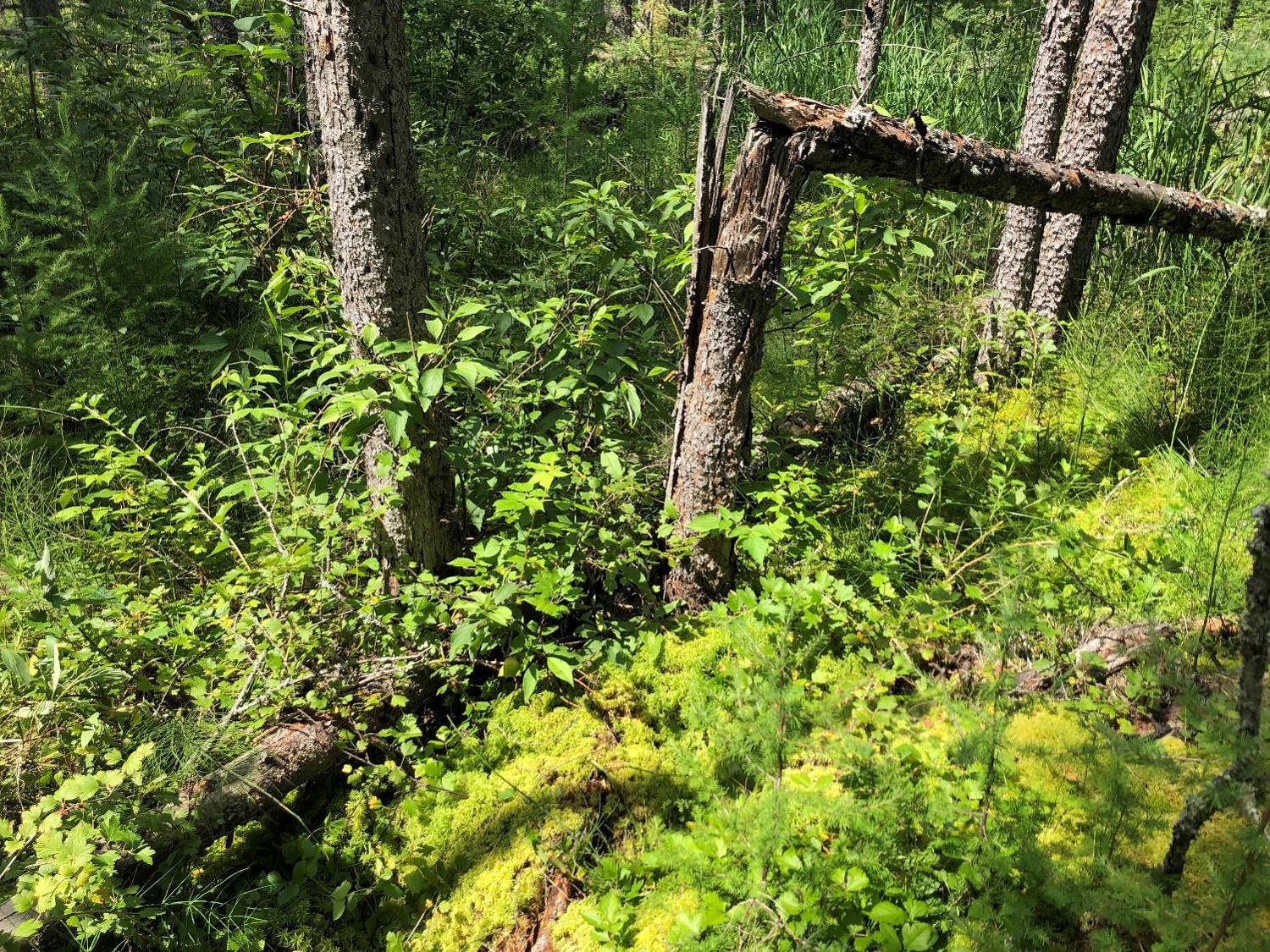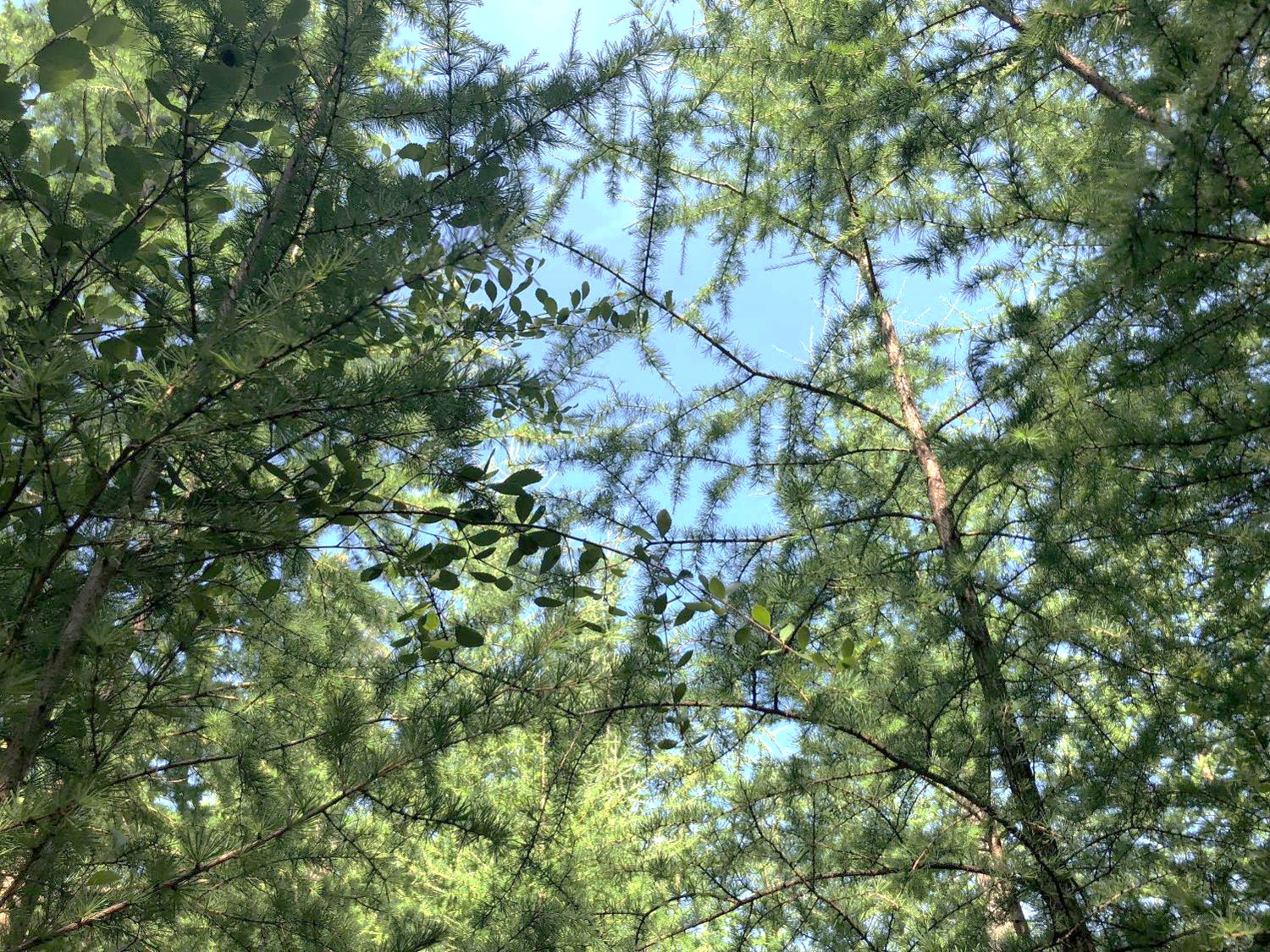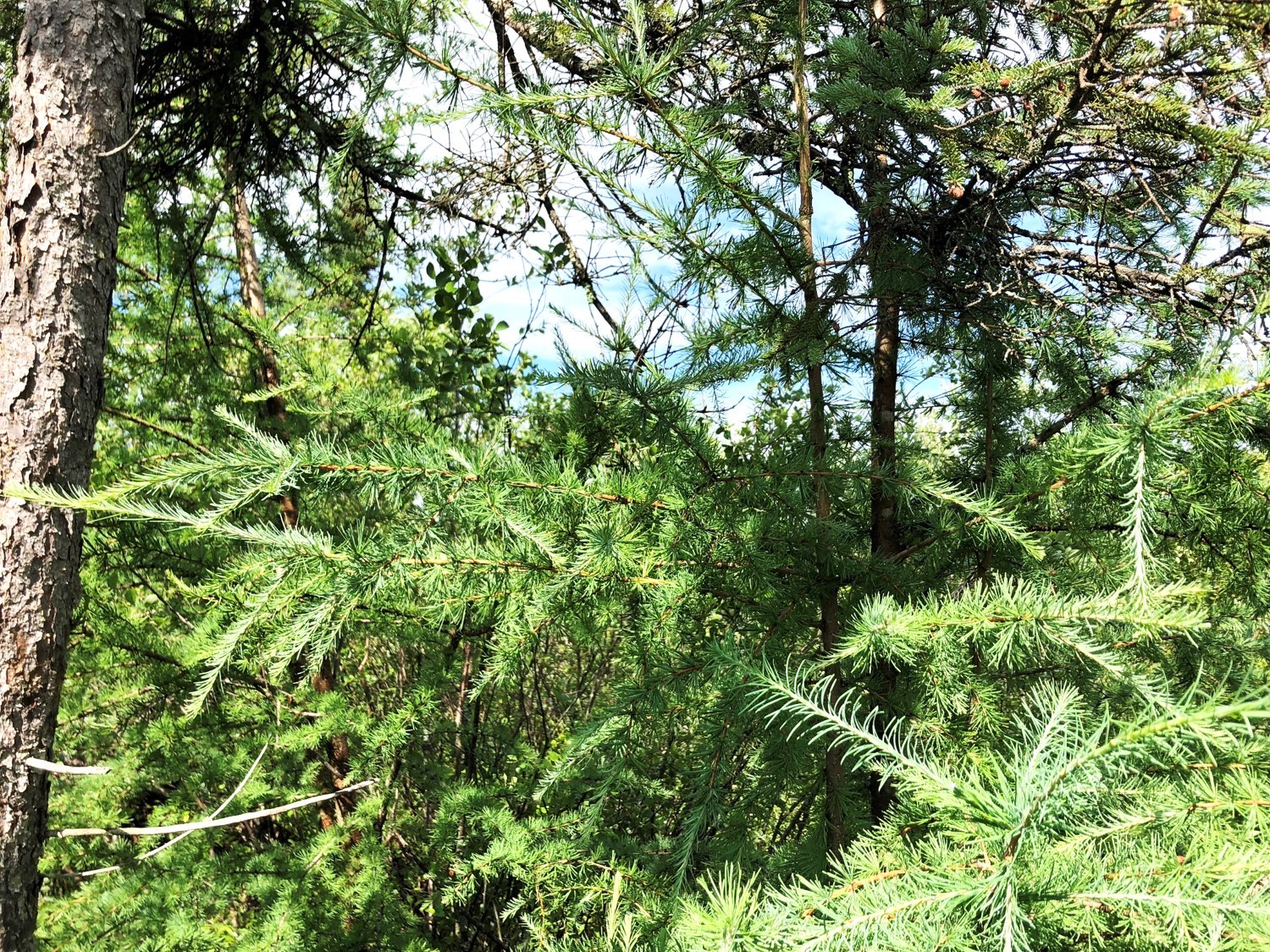Overview
Eastern larch beetle (ELB) is a native bark beetle that primarily feeds on tamarack larger than 4” DBH. Historically, eastern larch beetle outbreaks in Minnesota were localized and lasted three to six years. However, an outbreak that began in 2001 has been ongoing for 17 years and has affected more than 40 percent (534,900 acres as of 2018) of the tamarack forests in Minnesota (Supplemental Content [SC] Figures 1-3).
Researchers from the University of Minnesota discovered that a portion of the eastern larch beetle population is capable of completing two generations per year (McKee and Aukema 2015) despite normally requiring a period of cold weather to mature and reproduce. This change in reproductive capability has been linked to a longer growing season. Tamarack appear to be unable to tolerate the stress of a second attack from ELB in mid-summer.
Rapid stand mortality, decreased timber quality, low stumpage value, fluctuating markets, remote access, and poor frozen ground conditions are significant factors that have resulted in thousands of acres of unsold, unharvested, and dead standing tamarack across the state (MN DNR 2019). There is growing concern that tamarack may not be regenerating as mature trees are killed before they produce seed to grow the next generation of tamarack trees, resulting in large losses of forest and subsequent impact to ecosystems and wildlife habitat. Despite ongoing efforts to address ELB damage through timber and fuelwood harvesting, the DNR is unable to survey regeneration response in damaged, unharvested stands.

Figure 1: Stand 1 view of damaged canopy after ELB mortality.

Figure 2: Example of unharvested, mostly dead tamarack due to ELB.
Silviculture Objective(s)
• Manage even-aged types tamarack stands to balance age-class distribution
• Manage pests to control damage and reduce adverse effects.
• Implement silvicultural practices to establish a healthy tamarack covertype including conservation of live trees, snags, and dead wood
• Maintain examples of mature and old growth stages in forested rich peatlands for late successional wildlife habitat and Species in Greatest Conservation Need (SGCNs) on lands administered by the Division of Forestry
Pre-treatment stand description and condition
Stand establishment and management history:
Tamarack and lowland conifer stands originating from natural disturbance, (windthrow and insect mortality), timber and firewood harvest. Rotation age for productive tamarack stands (site index >36) is 80 years old.
Pre-treatment species composition:
Tamarack as the dominant species, with modest amounts of black spruce, white spruce and balsam poplar.
Pre-treatment forest health issues:
ELB damage and mortality is ubiquitous throughout the project area. The DNR Forest Health Unit mapped varying amounts of damage in 2007, 2009, 2011 and 2013.
Landowner objectives/situation:
• Identify damaged tamarack stands accessible by foot during the growing season
• Design a regeneration survey for a paired harvest and unharvested tamarack stand with a common soil type and native plant community class
• Quantify tree regeneration and size class
• Confirm if tamarack regeneration meets the Division of Forestry regeneration standards
• Support case study monitoring efforts as indicated in the Tamarack Assessment Project and Division annual work plan targets
Silviculture Prescription
A large clearcut with reserves timber sale was designed to salvage mostly dead tamarack. The sale price was reduced to $2.00 per cord to address market demand and help attract logger interest for biomass and roundwood products. All merchantable tamarack was specified for removal and full tree skidding was required to help redistribute any live cones across the treatment area. All non-tamarack species were reserved in clumps and as scattered trees for wildlife habitat and natural seeding. The desired future condition is to regenerate the site to a young age class of lowland conifers, maintain structural and plant species representative of a mature FPw63 growth stage, as appropriate, and increase the presence of long lived conifer species such as black spruce and northern white cedar.
What actually happened during the treatment
Harvesting with conventional logging equipment (feller-buncher, delimber and grapple skidder) occurred on frozen ground conditions during the winter of 2009. Approximately half of the volume was removed in stand 2 (SC Figure 4) over the course of the logging season. Permit extensions were granted in 2011 and 2012. However, due to unforeseen circumstances, no additional harvesting occurred and the timber sale expired in 2013. It is not clear why the timber sale expired prior to completion, but we suspect it is due to a number of administrative and onsite factors including poor conditions for frozen ground harvesting, large amounts of processing and roading needed to harvest 360 acres of salvage timber, low stumpage value for dead wood, and fluctuating timber markets for tamarack pulpwood. Standing timber charges were applied to the remaining tamarack and the unharvested area was left to naturally regenerate. Following the initial timber harvest treatment, the site was aerial seeded with black spruce at 2 ounces per acre in the harvest area and in portions of the uncut area to the south (SC Figure 4). Black spruce was selected as an additional regeneration species given its excellent suitability and natural regeneration potential in FPw63. An onsite regeneration survey was scheduled in 2015.
Post-treatment assessment
A field case study to assess tree regeneration in two previously damaged tamarack stands was initiated in response to recommendations for improving tamarack heath, timber, wildlife habitat and ecological diversity (MN DNR 2013a). The goal was to evaluate tamarack establishment under two scenarios in stands with ELB damage – a salvage harvest of recently dead tamarack and an unharvested site left to naturally regenerate.
In August, 2017 interns and field foresters collected a total of 74 regeneration plots for the project area, 28 plots located in the unharvested tamarack stands and 46 in the harvested stands (Table 1). Results show levels of recruitment in the unharvested Stand #1 of 511 crop tree stems per acre at year seven below our stocking standard of 600 tamarack seedlings per acre on 75 percent of plots. The harvested Stand #2 had over 3,000 stems per acre of crop trees at year seven, far exceeding our standards. While we do see lower levels of natural recruitment in unharvested and unseeded stands, it is encouraging to see some natural regeneration of tamarack where no silvicultural intervention occurred.

Figure 3: Stand 1 tamarack natural regeneration after EAB mortality.
What is not clear is if regeneration established before or after ELB damage (MN DNR 2013a). We think advanced tamarack regeneration (Table 1, n=72, saplings/small trees per acre) established prior to ELB due to a favorable light environment and microhabitat created by small scale windthrow and insect disturbance. It may be possible during a major insect infestation for ELB to attack cone bearing trees to the point that they immediately release their seeds. The rapidly changing light environment, favorable sphagnum moss hummocks and available water may allow tamarack to germinate and quickly rise above the shrub and sedges competition during the next growing season and in subsequent years.

Figure 4: Stand 1 released tamarack sapling after ELB mortality.

Figure 5: Example of tamarack seedling germination on a patch of sphagnum moss after ELB mortality.

Figure 6: Example of shrub and seedling response after ELB mortality.
Although Stand #2 was artificially regenerated with black spruce at 2 ounces per acre, survey results show nearly four times as many tamarack seedlings compared to black spruce seedlings. This is consistent with our understanding of tamarack tree suitability (MN DNR 2013b) and forester observations that tamarack regeneration and early stand development tend to outperform black spruce on rich forested peatlands while black spruce is more successful on poor acid peatlands (MN DNR 2016).
Unfortunately our team ran out of time to survey unharvested portions of the project area that were aerial seeded with black spruce (SC Figure 4).
Table 1 in the supplemental content section shows post-treatment regeneration counts up to a 5 inch diameter.
Plans for future treatments
GPS plots are archived for future case study sampling or stand modeling in both the harvested and unharvested stands. The harvested stand is “free to grow” with no future treatments expected at this time.
The University of Minnesota, in partnership with the USDA Forest Service and Minnesota DNR, received a two-year forest health monitoring grant to further understand and quantify tree regeneration (if present) and recruitment in stands impacted by ELB across a broader range of damage site categories and native plant communities. Our goal for "What’s Alive? Understanding the relationship between eastern larch beetle damage and tamarack regeneration" will be to sample 30 stands over two field seasons. Stands are classified into three comparable categories:
-
10 stands damaged by ELB in 2004-2008 – longer term regeneration dynamics
-
10 stands damaged by ELB in 2010-2014 – shorter term regeneration dynamics
-
10 healthy non-impacted tamarack control stands
Preliminary results are that 80% of the ELB damaged stands in the mid-2000s category are regenerating to a mixture of lowland conifer species possibly indicating seedling establishment and recruitment to adequate stocking levels may take longer than expected. Once fieldwork is complete, foundational forest inventory data will be available to more effectively determine if and how these areas are regenerating. Future silvicultural intervention may include using aerial seeding with tamarack, black spruce, and northern white cedar to supplement future regeneration in dead and dying stands, underplanting poorly stocked stands, or allowing others to naturally convert to open brushland habitat, an important wildlife habitat objective in the Agassiz Subsection of NW MN.
The DNR and University of Minnesota plan to update tamarack forest cover type guidelines and incorporate results into peatland native plant community silvicultural strategies where tamarack is desirable as a species of commercial and ecological importance
Costs and economic considerations
Timber sale revenue: $4,280 (estimate).
Aerial seeding, helicopter and seed costs: $18,250 (estimate – includes aerial seeding in unharvested portions south of the cut stands; SC Figure 4).
Other notes
Literature Cited:
McKee, F. & Aukema, B. (2015). Successful reproduction by the eastern larch beetle (Coleoptera: Curculionidae) in the absence of an overwintering period. The Canadian Entomologist. 147(5), 602-610.
Minnesota Department of Natural Resources (2013a). Tamarack Assessment Project.
Minnesota Department of Natural Resources (2013b). Suitability of Tree Species by Native Plant Community.
Minnesota Department of Natural Resources (2016). Lowland Conifer Status Report.
Minnesota Department of Natural Resources (2017). Minnesota’s Forest Resources 2017.
Minnesota Department of Natural Resources (2019). Conserving Minnesota’s tamarack forest in the face of an unprecedented bark beetle outbreak. USDA Forest Service National Silviculture Workshop.
The author would like to thank the Minnesota Department of Natural Resources, University of Minnesota, and USDA Forest Service for their collaboration and funding. Thanks to Rachael Nicoll, Megan O’Neil, Mike Reinikainen and Brian Schwingle for their contributions. We also want to recognize the following field foresters and interns for field collection, data entry and photography – Cora Gray, Mary Kordiak, Tyler Hasbargen, Joseph Kuhlmann, Michael Nooker, Trevor Olsen, Alexis Peasley, Rebecca Rickaby and Zach Suelter.
This case study was developed with support from the United States Department of Agriculture's National Institute for Food and Agriculture (USDA-NIFA), Renewable Resources Extension Act (RREA). Project #MIN-44-E02, principal investigator Eli Sagor, University of Minnesota.
Summary / lessons learned / additional thoughts
Initial case study results indicate that natural regeneration in unharvested stands is occurring but at low to moderate stocking levels (Table 1). The Division of Forestry should consider defining tamarack regeneration standards for damaged stands that are not available or suitable for timber harvest.
Prior to widespread ELB mortality, regeneration in tamarack stands has been a result of clearcut with reserves and seed tree silvicultural systems. Healthy, live trees are left randomly scattered as singles, clumps, or in strips throughout a harvest with the intent to provide adequate future seed source for natural regeneration. In the last decade, however, we have seen an increase with larger clearcut-salvage harvest prescriptions in an effort to remove timber under threat or direct attack from ELB.

Photo 7: Example of understocked tamarack stand after ELB.
Field observations and conversations with foresters suggest that poor tamarack regeneration due to ELB infestation can occur in years of low seed and cone production. Low available seed in conjunction with unsuitable seedbed due to lack of disturbance such as logging can lead to low stocking. Without live seed trees, artificial regeneration using a helicopter to disperse seed may be necessary to regenerate tamarack and meet stocking standards. Consequently, silvicultural practices are shifting away from reliance on natural seeding while nursery seed extraction and aerial seeding investment are increasing significantly. Furthermore, tamarack seed supply at the State Forest Nursery can be quickly depleted in years with large clearcut salvage sales that call for tamarack seed, possibly resulting in having to select alternative conifer species for regeneration or relying solely on available onsite seed. Foresters must carefully weigh the benefits of large clearcut-salvage tamarack harvests (> 100 acres) against market value, logger interest, presence of live seed trees, and available seed supply for artificial regeneration.

Photo 8: Example of tamarack seedling regeneration after clearcut salvage harvest (stand 2).

Photo 9: Example of tamarack and black spruce natural and artificial regeneration after clearcut salvage harvest (stand 2).
The future of Minnesota’s tamarack resource remains uncertain. Average annual mortality continues to outpace net annual growth (MN DNR 2017) and harvesting remains well below long-term sustainable levels. Future age class distribution may shift toward older, two- or uneven-aged forests with an increase in open brushy conditions and poor tamarack regeneration in portions of the state where ELB mortality is greatest.
Supplemental content

Accumulated acreage of ELB damage in Minnesota

Spatial distribution of ELB damage in Minnesota.

Aerial view of dead standing tamarack

Map featuring unharvested and harvested stands
Tamarack poster from USFS Silviculture Workshop
